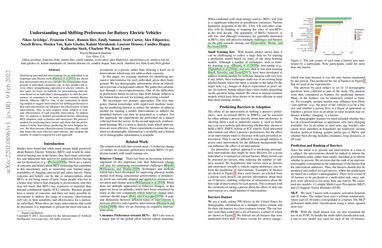Understanding and Shifting Preferences for Battery Electric Vehicles
Identifying personalized interventions for an individual is an important task. Recent work has shown that interventions that do not consider the demographic background of individual consumers can, in fact, produce the reverse effect, strengthening opposition to electric vehicles. In this work, we focus on methods for personalizing interventions based on an individual's demographics to shift the preferences of consumers to be more positive towards Battery Electric Vehicles (BEVs). One of the constraints in building models to suggest interventions for shifting preferences is that each intervention can influence the effectiveness of later interventions. This, in turn, requires many subjects to evaluate effectiveness of each possible intervention. To address this, we propose to identify personalized factors influencing BEV adoption, such as barriers and motivators. We present a method for predicting these factors and show that the performance is better than always predicting the most frequent factors. We then present a Reinforcement Learning (RL) model that learns the most effective interventions, and compare the number of subjects required for each approach.
PDF Abstract
